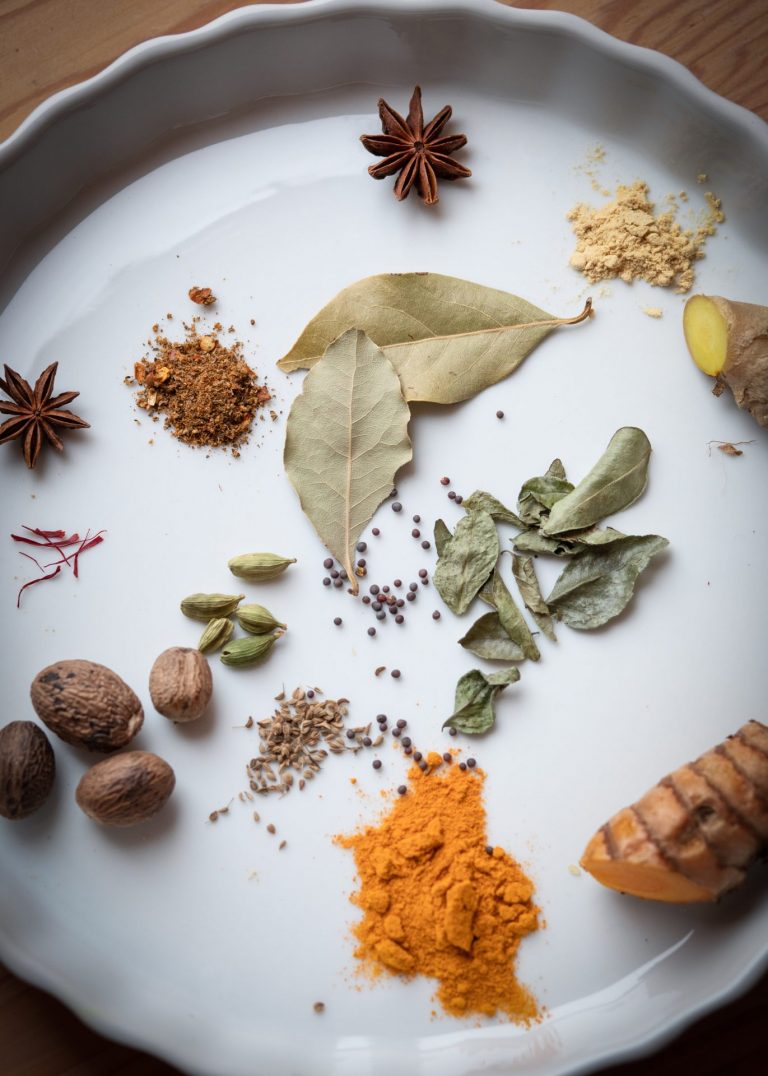Everything is allowed in Ayurveda - Even Mushrooms
Truth be told, Ayurveda does not say no to any food items that are in the seasonaL, organic and local list. Nevertheless, I find endless reels, memes and writings about how you should not have mushrooms, peanuts, tomatoes, aubergines, potatoes, peas and so on. The warnings on mushrooms are particularly popular. Me instead, I will urge you to eat these super healthy and tasty foods and will justify my position by explaining
- Food qualities (gunas) and seasons
- Food energetics (trigunas)
- Your digestive fire (agni)
GUNAS
 In Ayurveda we seek balance and this balance works by the law of opposites based on how foods like for example mushrooms feel like. Ayurvedically observed mushrooms are inherently heavy, warming and grounding, helps us to rest and sleep. By this logic of polarities, they are appropriate in a moment when we feel light, dry and cold. Just like when you feel cold you get better by warm comforts. The law of opposites is set in physics.
In Ayurveda we seek balance and this balance works by the law of opposites based on how foods like for example mushrooms feel like. Ayurvedically observed mushrooms are inherently heavy, warming and grounding, helps us to rest and sleep. By this logic of polarities, they are appropriate in a moment when we feel light, dry and cold. Just like when you feel cold you get better by warm comforts. The law of opposites is set in physics.
Each food item and activity can be qualified. There is no such thing that cannot be qualified. Try thinking about something, anything in the world, and you can immediately give qualifying words to it. Adjectives are imbued into everything.
Qualities can be set in opposite pairs. Hot – cold, heavy – light, dry – moist. Put this principle in practice and you find it’s something you do all the time. When your skin is dry you moisturise, when you feel hot you cool down. If you eat drying foods, such as asparagus (it makes you pee) you’ll reduce excess liquidity, puffiness in other words.
The qualities and the polarity theory mean that everything can be potentially used as medicine, mushrooms and all other “banned” vegetables included. We need their qualities to be in direct opposition to the feelings in us that need balancing,
The defining factor are the qualities present, the ones we feel in the moment.
We have the context to think because…
Everything can be equally toxic. If you feel heavy and sleepy already and need to stay awake, mushrooms not the best remedy food for you.
SEASONS
Now, let’s consider the seasons. Each season feels different. Winter is cold and light, spring is heavy and moist, summer is hot and light. If you have heavy mushrooms in spring, when they are not in season, you might create a health issue.
Autumn and winter increase feelings of lightness, cold and dry. As if by magic, mushrooms grow mostly in late summer and autumn and can be easily preserved for winter by drying them. They are perfect sustenance in the period of scarcity (lightness). They also increase immunity and stamina, well needed in winter.
 Nature is very clever. What grows in each season is appropriate to balance seasonal imbalances and disorders. What grows in summer is juicy and sweet to balance the effects of heat. Spring foods are light and detoxifying to balance the heavy wet climate. Winter brings dryness and lightness and hearty winter foods are the best remedy. Creamy mushroom pasta is a perfect ayurvedic lunch in winter.
Nature is very clever. What grows in each season is appropriate to balance seasonal imbalances and disorders. What grows in summer is juicy and sweet to balance the effects of heat. Spring foods are light and detoxifying to balance the heavy wet climate. Winter brings dryness and lightness and hearty winter foods are the best remedy. Creamy mushroom pasta is a perfect ayurvedic lunch in winter.
ENERGETICS
Mushrooms, and all other food items, can be described with qualities. There is, however, another dimension of food, in addition to the qualitative approach, namely the food energetics. By understanding the energetics, we can arrive to the conclusion that mushrooms, and any other food item for that matter, can be enjoyed as healthy food.
Food energetics refer to food items’ ability to stimulate or calm the bodymind. Chilli and coffee are stimulants. Mushrooms are the opposite. They calm and ground. The stimulating energy is called rajasic whilst the calming and grounding one is called tamasic. We need both these energies to carry out our lives. Rajas equals action, tamas equals inaction.
When an organism performs activities and rest in harmony it is said to be in a sattvic state, the third dimension of the energetics. Sattva is a given, inherent quality to all plants and animals, except humans.
 The sattvic aspect of plants is a result of them following the cyclic life of nature and doing exactly what they are supposed to be doing. They live their dharma 100%. They cannot choose to stop growing or procreating. They cannot decide to go for a walk, a behaviour untypical to them. Humans can stop moving, lie on a couch and watch tv with a bucket of ice cream, all day long. We have the choice and our choices are often not so sattvic.
The sattvic aspect of plants is a result of them following the cyclic life of nature and doing exactly what they are supposed to be doing. They live their dharma 100%. They cannot choose to stop growing or procreating. They cannot decide to go for a walk, a behaviour untypical to them. Humans can stop moving, lie on a couch and watch tv with a bucket of ice cream, all day long. We have the choice and our choices are often not so sattvic.
Sattva is a positive energetic stamp on rajasic and tamasic foods. It is found in fresh, organic, local and seasonal foods that have grown mature in their natural habitat, are eaten fresh, are organic and seasonal. When these elements are gone food is less healthy and energetically negative. It can irritate or suppress the mind. Processed foods are the worst of them.
Sattva is not a separate state on its own. The balance is in the activity or in the rest. If your life is in balance, you feel like its flowing. If there’s no flow, you struggle or feel like things are not moving to the right direction. You might be in bed but can’t fall asleep or have a terrible nightmare whilst sleeping and wake up exhausted. Flow and restoration are the effects of sattva affecting action and inaction
Mushrooms grow in perfect balance and flow with nature’s cycles. They surface right when we need them. Their nature corresponds exactly to our nutritional needs during their appearance. They are sattvic by abiding to the commands of Mother Nature. Assuming they grows in the forest and not on the side of a motorway, we can say they are pure and sattvic with a healthy tamasic twist.
 Tomatoes often suffer the same treatment in the hands of ayurvedic food dietetics. Still, there is a whole Mediterranean area that feed on tomatoes almost daily and still they are considered to be enjoying the healthiest of diets in the world. There should all be dead by now!
Tomatoes often suffer the same treatment in the hands of ayurvedic food dietetics. Still, there is a whole Mediterranean area that feed on tomatoes almost daily and still they are considered to be enjoying the healthiest of diets in the world. There should all be dead by now!
Tomato belongs to the nightshade family with aubergines peppers and potatoes. They come in season in summer and can be kept or preserved for the winter. Most interestingly, the nightshades are mainly eaten cooked. Cooking eases digestibility of these vegetables (fruits actually). Cooking and seasoning makes them easier to digest. Raw tomatoes are a struggle to digest and should be avoided by those who have a weak digestive power which makes me enter the third point in my quest to justify the inclusion of the banned fruits and vegetables in our ayurvedic diet.
DIGESTIVE POWER – AGNI
Digestibility defines the nutritional value of your food. Digestibility is hugely improved by cooking food, especially of potato and aubergine. Who would eat them raw anyway? Tomatoes can be eaten raw. However, cooking them releases lycopene, one of the most powerful antioxidants found so far.
There’s no denying, nightshades are more difficult to digest, especially if you eat them raw. By cooking them you get delicious dishes with easy digestibility. Imagine, dishes consisting only of nightshades like Greek moussaka should be banned? Not from my diet, thanks.
To conclude, food choices need to be appropriate for the context, timing and obviously, our own sensitivities. Without absolute no-nos, everything that is freshly prepared and cooked and eaten with respect, that is seasonal, organic and local has a potential of enhancing balance in you by its sattvicity. Understanding the variables at play you can certainly enjoy foods that might pose a challenge otherwise.
The title of this article is a bit provocative but not far from truth. The truth is in the nature. When we eat and do things that are natural to us then within those limits we can find that every food has value when it is eaten with respect and placed and timed right.
Viva la mushroom!






Leave a Reply
You must be logged in to post a comment.